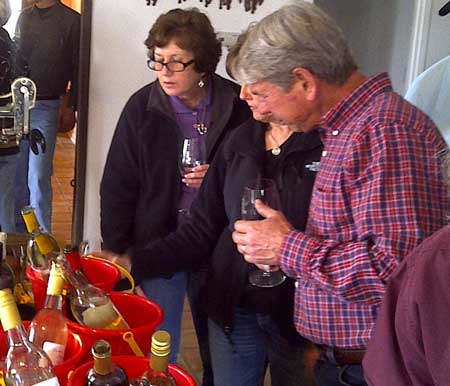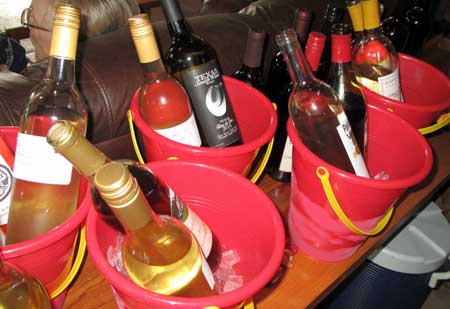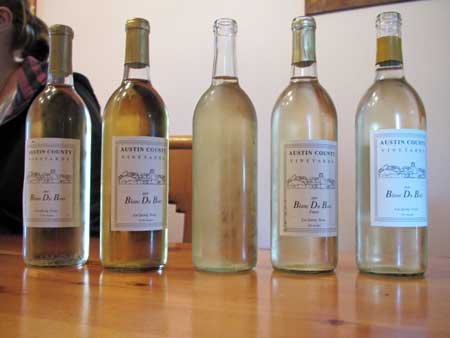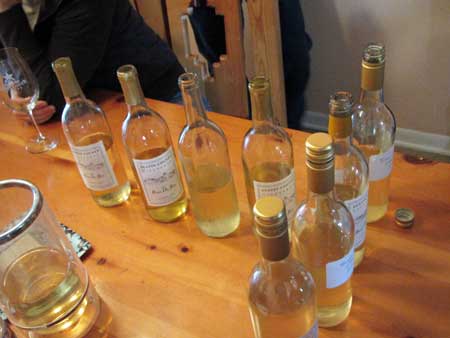On the Gulf Coast Wine Trail…Blanc Du Bois Vertical/Horizontal Tasting.
Or, Better Tasting Through Chemistry
I hit the road again after receiving an invitation from Jerry Watson of Watson Vineyards in Cat Spring, Texas. Jerry said that some of his fellow Texas Gulf Coast grape growers pooled their chemical orders for pesticides, fungicides and the like, and were going to pick up the chemicals at Saddlehorn Winery in Burton, Texas.
Well, to make a short story shorter, Jerry and his friends felt that this meet-up was as good excuse as any for the winegrowers to taste some wine and I was invited. I figured that the tasting could be called “Better Tasting through Chemistry”.
However, the tasting wasn’t just any wine. This tasting involved Texas wine and to make it even better, the tasting was featured some of the wines from two hybrid grapes varieties that are fast becoming Gulf Coast specialties made by commercial and not-yet-commerical winemakers. The star of the event was Blanc Du Bois, a Muscat-like white wine grape developed in Florida, but with more acres growing in Texas than anywhere else in the world of wine. The supporting yet important role in the tasting went to Black Spanish, a red grape also known as Lenoir that has a long yet mysterious history in Texas of over a hundred and fifty years.
The ride up Route 290 to Saddlehorn Winery was relaxing and pleasant under the sunny Saturday morning sky. However, the day was slowly starting to morph into a more normal winter scene of gray overcast, an omen of the frigid weather approaching from the northern extremities of the continent. As I arrived, the promised chemical stash was nearly gone and the growers were making their way to the nearby house.
I opened the door and was greeted by Jerry and Cozette Watson, hosts Steve and Galin Morgan (Saddlehorn Winery), many familiar locals and some new acquaintances, all critically tasting and discussing the attributes of their Gulf Coast 2010 vintage wines. I was given a glass and told to dig in.
First up, I spied Paradox House Vineyard Blanc Du Bois Sur Lie. Recognized it from the Austin Country Fair wine judging I did a few months ago. It offered a great nose: complexity between sweet fruit and toast followed by a silky soft feel and a crisp, near-dry finish.
Next, I came across another crisp Blanc du Bois from Alta Mira grown near Anderson, Texas, and then veered off into a few more Blancs, but this time they were off-dry to semi-sweet versions that had a great combination of acidity and sweetness.
From there, Steve offered me a taste of his semi-sweet Muscat and a dry and semi-sweet versions of his Sanddlehorn Black Spanish wines as lunch was served. The Saddlehorn Winery Black Spanish Sweet Wine (Washington County, Texas, NV, Non Vitis Vinifera Reds) was a winner at the recent 2011 Houston Livestock Show and Rodeo International Wine Competition.
Jerry added a dollop of excitement to the occasion with a personal performance: a vertical tasting consisting of five vintages of his Blanc Du Bois [PDF] wines spanning 2005 to 2010. I caught most of it on video, but the upload to YouTube still isn’t going well and I’m still working on it.So much for an old dog confronted with new Internet tricks.
Jerry normally makes his wine just a shade up in residual sugar (RS) from dry with RS values ranging from 0.75 to around about 1 percent, but with the great acidity of early harvested Blanc Du Bois grapes. The RS is not really perceptible except as a smooth soft finish on the wine. To me this level of RS in Blanc Du Bois is like what a pinch of salt does for my homemade soups.
The vertical tasting was an interesting experience.First of all, the 2005 wine was starting to darken, but was still a mighty fine wine with just a gentle hint of sherry on the nose combining with the still dominant pear and citrus qualities of the wine. The 2005 was followed by the 2007 Blanc that Jerry admitted to having “screwed up”. The wine had a secondary fermentation in the bottle that consumed the RS resulting in a dry, mildly sparkling white wine. I would hardly call this a “screwed up wine” as Jerry effectively followed a “kind of” Methode Champenoise process, yielding a wine of east and toast character providing much the same experience brought by an Italian Prosecco or Spanish Cava, but made with Texas Gulf Coast Blanc Du Bois.
The 2008 Blanc Du Bois was a bottle contributed by Steve Morgan that was made in a somewhat dried style than Jerry normally uses; it had only 0.5 percent RS. It was crisp and offered a exciting fruit aromas and flavors: again the characteristic pear and citrus. The 2009 Blanc Du Bois was the most interesting of the bunch with a minty note lingering on the nose. We were searching for a descriptor and finally agreed that it was something like a very light eucalyptus. Jerry confessed that he tasted it too, but didn’t have an idea as to its origin. Jerry’s experience with Blanc Du Bois spans about a quarter of a century, but I guess there is still more to learn about this grape. Finally, Jerry presented his 2010 Blanc Du Bois that was clean and crisp with a fruit-driven, peach/pear quality and a comfortably soft finish.
No sooner did we finish the vertical tasting of Blanc Du Bois than Steve set down another three bottles on the table. However, he arranged perpendicular to the row of Jerry’s wines intersecting them at the 2010 vintage. Then, Steve announced to the assembled growers that the vertical tasting had now morphed into a horizontal tasting of Blanc Du Bois wines from 2010. The new wines sported only handwritten labels, but Steve explained that they spanned RS contents from near zero to over 4 percent which nicely bracketed Jerry’s wines made at around 1 percent RS. All had wonderful fruit flavors, varying sweetness and wonderful sugar-acid balance.
As I’m sitting here recalling the wine tasting and blogging, what impresses me is the innate versatility of the Blanc Du Bois grape. It’s a grape that can be grown in nearly any part of the state (unlike European-style vinifera grapes) without fear of the Texas winegrowers scourge – Pierce’s Disease, and it can be made into just about any wine style from dry to sweet, still to sparking, and with or without oak.
Blanc Du Bois may have started out its meager existence in a Florida research vineyard, but as with many of us “Naturalized Texans”, it got here as quick as it could. With more of it growing in Texas than any where else, it’s now proudly wears its Texas brand. In fact, Blanc Du Bois has done so well in the Texas Gulf Coast and Post Oak belt region around Austin and Brazos Counties (around 200 acres planted), that the growers are looking into establishing this region as a new American Viticultural Area (AVA) for Texas.
My recommendation is to pick your style and try a Texas Blanc Du Bois as soon as you can. Blanc’s a trend in Texas wine drinking that I’m sure will spread around the state.





I am a huge fan of it and believe like you that it has a ton of potential.
It could be the Picpoul/Catarratto/Torrontes of Texas.
WOW! I am all excited about seeing Blanc in a screw cap! That is exactly what this varietal needs to preserve it better!
I think its funny how these non-commercial winemakers are using screw caps with blanc I wish more commercial wineries would use them, however I know it really cost allot more to use them instead of corks.
Blanc is best unfiltered and not cold stabilized which I think is what the Austin County wines are, however I am curious of the stable aging potential when they are not. Do you not run a greater risk of refermenting even with .50% RS?
I have seen this happen in Blanc that has been cold stabilized (but not cold enough) and filtered.
I really think 09 was a very unique year for blanc du Bois and the ones I have tried in my neck of the woods have been somewhat different yet good compared to the really good years.
From what I have learned talking to many winemakers about the grape, its very easy to make it good in small batches the trouble gets to when you start trying to do it in larger tanks. They say thats where it gets tough. And then to sell it commercially people expect it to be filtered and you have to cold stabilize and that strips the wine of all the good stuff.
Small production Blanc is probably the best kept secret here in Texas and you are totally right Blanc du Bois is Texas own grape now. If you do not think so try some Florida Blanc du Bois.
We all have Mr Raymond Haak to thank for this great grape!
I believe that Texas does make a great Blanc , but Florida also makes a great Blanc as well. You just have to find it. Royal Manor Blanc took gold in the Indy International, and Silver at Hilton Head Island.. So it is hard to put all of Florida in the same bunch of grapes.
Florida developed Blanc Du Bois, but not many wineries in Florida are making wine with it any more. There have been lots of problems with rot and other fungal and disease pressures in Florida.
There are now more acres of Blanc in Texas than any other place on the planet. We much appreciate the effort to our brothers and sisters in Florida, and will continue to enjoy the wine. We have finally learned how to grow it here and make it into a mighty fine wine ourselves.
I believe that in general most Floridians don’t want to take the time or effort to learn how to grow this wonderful grape. Some of my Blanc vines stayed under water for four or five days as well as some of my muscadines which died. The Blanc rebounded without one loss.
I personally Can’t compete with the acreage but keep an eye out for Royal Manor Wines as I believe that with a little extra effort we can compete with the Texas wine makers. Cheers
Thanks for the kind words on Blanc du Bois, James, I feel passionately that it is truly a Texas wine variety that fits our Texas terrior.
I have been working with this grape for over 25 years and my enjoyment and passion for it continues to grow. We produce seven different styles of commercial wine from this one varietal and each have a loyal following wirth our customers.
As far as winemaking is concerned, Blanc du Bois is a straight forward varietal to produce wines from. Using sound winemaking practices, there are no “tricks” or “insider” knowledge required to produce premium wines. The most important variable is determining optimum fruit ripeness to match the style and flavor parameters desired for each wine style. Lower pH (3.25-3.35), higher total acidity (8.5-9.0 g/l) for off-dry to desert wines and higher pH (3.35-3.5) with lower total acidity (7.0-8.5 g/l) for dry style and barrel aged/sur lie wines. As far as cold stabilizing wines it does not remove any flavor compounds, only Potassium/Magnesium Tartrates that will become insoluble with age and lower storage temperatures. The thing to remember is filtration only removes suspended solids and it improves and enhances the brilliant sparkling clarity to the wines and increases its visual quality. Filtering wine with a filter rating of 0.5 micron or less will remove any residual yeast in the wines and this coupled with good sterile hygiene practices in the winery will greatly reduce the possibility of secondary fermention of any residual sugars in the bottled wines.
I apologize for the “excessive” wine geek above, but it is important to stress the straight forward rigors needed to produce premium Blanc du Bois.
The main thing to take away from this blog is to enjoy Texas Blanc du Bois!
Bon Appetite!